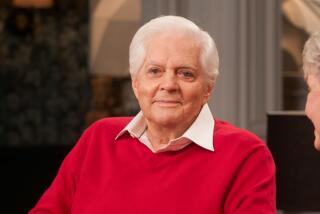Tribute to a tap master
- Share via
NEW YORK — There was a red carpet outside Harlem’s famed Apollo Theater on Sunday evening and a capacity audience inside. Enthusiastic and vocal, the crowd was eager to pay tribute to Gregory Hines, who died of cancer Aug. 9 at age 57. The theater is where Hines’ exemplary and multifaceted career began as a boy in the 1950s.
There was also a warm familial flavor to the event, which was directed and co-hosted by Hines’ older brother, Maurice, and featured appearances by the late dancer-actor’s father and son. Maurice and Gregory performed side by side from their earliest years, growing up to appear together on Broadway in “Eubie!” (1978) and on film in “The Cotton Club” (1984).
The nearly three-hour-long “All Out Celebration,” as the invitation billed it, was also a display of past and present Broadway talent. Leslie Uggams, Diahann Carroll and Andre De Shields sang, while Chita Rivera and Ann Reinking delivered the essence of Bob Fosse style in a number from “Chicago.” Savion Glover, in an extended, impassioned tap solo, displayed the range and daring that have made him Hines’ heir when it comes to breaking new ground.
Glover danced shortly after Maurice Hines introduced Fayard Nicholas, the surviving half of the brilliant Nicholas Brothers dance duo. Hines recalled how he and Gregory, as children, sat in the Apollo’s back row with tap teacher Henry LeTang to watch the Nicholas Brothers perform. Nicholas was seated in a box close to the stage, and Glover seemed to direct his dancing toward him. It was a moving acknowledgment of tap dance generations. Just as Hines learned from the Nicholas Brothers and many other tappers of an earlier time, Glover worked closely with Hines, learning from his innovations.
This was not primarily an evening of eulogies, however, but an outpouring of music and dance for a performer who always took delight in the accomplishments of his fellow artists.
Maurice did speak warmly and affectionately of his younger brother while photos of them as child performers were projected above the stage.
They first appeared at the Apollo as the Hines Kids in 1954. “I brought him home because this is where it began,” Maurice explained early in the evening. He was joined onstage by Maurice Hines Sr., a drummer who joined his sons’ act -- which was renamed Hines, Hines and Dad -- and who performed frequently with them on television.
The audience Sunday at the Apollo included Denzel Washington, Mikhail Baryshnikov, Jasmine Guy, Debbie Allen, Lenny Kravitz, Tommy Tune, Eartha Kitt, Bobby Short, Roscoe Lee Browne and Geoffrey Holder. One row of the theater held nearly the entire cast of “Eubie!,” a 1978 musical revue in which the Hines brothers made their Broadway breakthrough and for which Gregory Hines earned his first Tony Award nomination.
Gregory Hines’ unique, innovative tap style was displayed in clips from the 1985 feature film “White Nights” and the 2001 Showtime movie “Bojangles.” Despite the Broadway flavor of the program, there were no clips of Hines in a musical. But Ann Duquesnay, one of his original co-stars in 1992’s “Jelly’s Last Jam” -- the show about Jelly Roll Morton for which he won a Tony -- delivered a searing number from its score.
Late in the evening, there was time for more intimate recollections. Zachary Hines, Gregory’s 20-year-old son, came onstage to speak of his father the human being rather than the performer. “His compassion for his fellow humans extended beyond his family and friends,” the son noted, recalling his father’s generosity and capacity for forgiveness.
“He was given two months to live and he lasted 13,” he revealed of his father’s battle with cancer, of which many were unaware. “He always lived in the present moment, and that’s what he did during those 13 months.”
Just before the program concluded, Maurice Hines put aside his role as jovial, show-biz host. “I miss the sound of his voice,” he said, recalling how he and Gregory would call each other at all hours. He then danced a simple, tender soft-shoe alongside a spotlight, ending with a final gesture of his hand toward his no-longer-visible but still powerfully present partner.
More to Read
The biggest entertainment stories
Get our big stories about Hollywood, film, television, music, arts, culture and more right in your inbox as soon as they publish.
You may occasionally receive promotional content from the Los Angeles Times.










